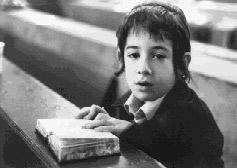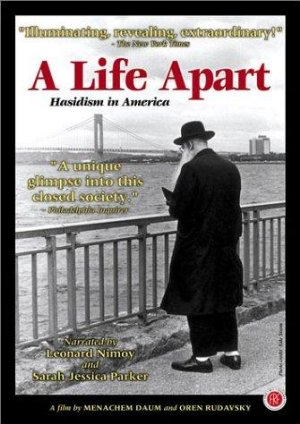A Life Apart: Hasidism In America Review
By Julia Levin

Even among different denominations of Jewish religion, Hasidism stands alone, a religion of minorities among minorities. The invaluable quality of this film is that it neither critiques nor praises the Hasidic religion. For a subject matter as extreme and uncompromising as the religion itself, A Life Apart is wonderfully even-handed. Throughout the film, which starts and concludes with an exuberant wedding ceremony underlying the significance of ritual for the Hasidic community, we dig into the mystic philosophy behind the Hasidic refusal to participate in the contemporary world.
Unwilling to obey societal rules, Hasidic Jews, the majority of whom came to America in the 40s and 50s, still evoke disdain in mainstream society. Described by many as smelly, ugly, and mean looking, they consider themselves a spiritual elite, thus not mingling with non-Hasidics. To keep their Hasidic life style, they deny the very premise of attaining the American dream.
Narrated by Sarah Jessica Parker and Leonard Nimoy, the film traces the roots of Hasidic teachings, first introduced by Baal Shem Tov, a founder of Hasidism who made complex spiritual ideas accessible to less educated people. His way of explaining the presence of God by sanctifying routine activities and everyday occurrences gave his followers deeper spiritual meaning.
The geographic trajectory of A Life Apart reaches as far as Ukraine, where the Hasidic movement originated, and Moscow, once an epicenter of anti-religious destruction and where Hasidism is experiencing an enormous revival today. The focus of the film, however, remains constant: an intimate examination of vibrant, ritualistic Hasidic life in Brooklyn, a center of the Hasidic world.
In a series of interviews, Jewish theological scholars, community members, and their families -- as well as non-Jews -- discuss the struggle between traditionalism and modernism and pose questions about the central ideas of Hasidism. Hasidism means giving up a majority of occupational options and, therefore, subjecting their families to a life of severe financial restraint. It means never sending one's kids to college or a regular school, watching television, or going to the cinema (which means they won't be seeing this movie).
Against the multicolored, multiracial New York landscape, Hasidim, in their black coats, sidelocks, and enormous hats, look shockingly foreign, yet as the film demonstrates, they are American Hasidim. By the end of the film, much to my surprise, the same wedding I watched at the beginning nearly touched me to tears, for it acquired a different meaning. I have never been one for sentiment, but I do believe that this is what good art should be able to do: To give us back to ourselves and transform our preexisting beliefs or ignorance into something new.
A Hasidic Jew prepares.

Facts and Figures
Year: 1997
Run time: 96 mins
In Theaters: Saturday 1st November 1997
Reviews
Contactmusic.com: 4.5 / 5
Rotten Tomatoes: 100%
Fresh: 6
IMDB: 6.6 / 10
Cast & Crew
Director: Menachem Daum, Oren Rudavsky
Producer: Arnold Labaton, Menachem Daum, Oren Rudavsky
Screenwriter: Menachem Daum, Robert Seidman
Starring: Leonard Nimoy as Narrator, Sarah Jessica Parker as Narrator
Also starring: Arnold Labaton, Menachem Daum, Oren Rudavsky, Robert Seidman














